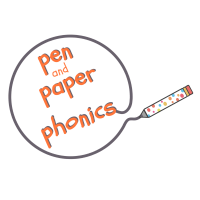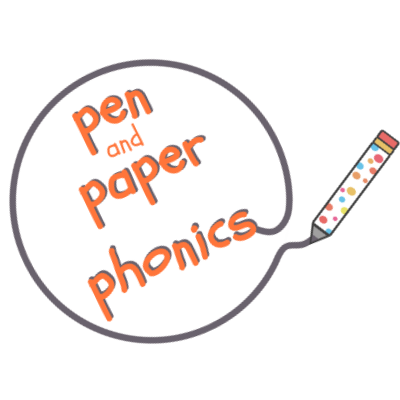
Reading two letter words with a Vowel-Consonant (VC) pattern – such as ‘at’ – is a great beginning step in learning to read. It is a simple way to teach the ‘sounding out’ process and the student only needs to know a few letter sounds.
Bingo markers or dot art pens are a fun and engaging way to teach and practice these skills.
New to penandpaperphonics.com? Click here to find out more.
Background to Vowel-Consonant Words
Or, jump straight to the activity
Words in English are written with vowels and consonants. Every word in English has a vowel sound. There are lots of different spelling choices for vowels, but when children begin reading, they are introduced to ‘a’, ‘e’, ‘i’, ‘o’, and ‘u’.
When a child is first learning to read, they learn the letters of the alphabet and the most common sound those letter make. Then they begin to blend the sounds together to make words/read words.
Vowel-Consonant words are words like ‘at’ that have a vowel and consonant. There are only a few combinations of these and so they are a great way to introduce the concept of sounding out (segmenting) and blending.
Want to find out more about blending and segmenting sounds to read words? Click here.

The Basic Idea: Dot Art VC Words
The basic idea of this activity is to use dot markers or bingo markers to help read VC words.
Using dot art markers allows the young reader to slow down and carefully sound out the letters in order to read the word. It also adds movement and a tactile element into the reading process, which can help to improve focus and provide another multi-sensory pathway to successful reading of the word.
So, lets get to it!
Wondering if this activity will be suitable for your child’s reading level? click here for more information.
What You Will Need

- Paper.
- Bingo/dot markers.
- A list of the vowel-consonant words you are going to use (see resources section of this post for ideas).
- Optional: activity flashcards from the resources section of this post to help with the placement of the dots (nice to have but not necessary for a successful activity).

In the resources section of this post there are free printable words lists as well as flashcards to use with this activity.
How to Play
1. Write the first vowel-consonant word fairly large, on the paper.
- You can do any order of words based on the vowels and consonants that the student knows. But a suggested order would be: at, am, an, it, on, up.

2. Model what to do: Sound out each letter and as you do so, put a dot under each letter.


3. After you have sounded out each letter, say the whole word. As you say the word, draw a line under the word. For example “/a/ (dot), /t/ (dot), AT!”


4. Using the same word, ask the student to repeat the activity. I tend to use one color only, but if it increases interest, allow the student to change colors for each word.
5. Give the next word, and work on through the list.

6. When they have done all the words individually, and if they are ready for different vowels, work through the rest of the words.


To Note
Sometimes, a child may only be ready to do the first 3 words, with only the letter ‘a’. Just tailor the activity according to their needs. Doing the first three words will still teach them the process of reading, as well as give them quick success in making words with the letter sounds that they know.
Dot markers are fun and children can love to be creative with them. So, they might not want to use them to dot under the letter. If that’s the case, you could have a spare paper where after (or before) the activity they can dot as much as they like. But during the activity, just dot the letters.

How to Adapt

Trace the Letters:
After dotting the letters, trace over them with the markers and read the word again. There is a pleasant tactile element as the marker goes over the letter, and it adds another multi-sensory letter formation element to the activity.
Change the Words:
This is a great activity to do with whatever words a student is ready for. You could use CVC word families, as well as a mixed collection of CVC words. Words with blends, digraphs and vowel teams would also work well. In this activity, the dots help to reinforce the idea that the digraphs and vowel teams make one sound, but the blends make two individual sounds.


Identify the Vowels:
Dot markers are a great way to highlight the vowels or the consonants. So, as the student sounds out, get them to use one color for vowels and another color for consonants.
Don’t have Markers?
Use a dry wipe board. Dot markers are great, but if you don’t have any, this activity can be done with dry wipe markers, or with small objects like game counters.

Take it Outside:
There are lots of ways to do this outside. Chalk out large words, and then draw a circle under each letter. Have the student jump from one circle to another saying the sounds as they do so, and then reading the word. You could also write the words and then use objects such as nuts, leaves or sticks as the dots under each word.


Resources for Vowel Consonant Words Activity
Downloads/Printables
Printable Resources for Dot Art VC Words Activity
If you are interested in VC and CVC words, check out these products in my TpT store:
Related Content
These are lots of phonics activities on this site. The ones below are also based on letter sound recognition and blending and segmenting.
There are so many great ideas for teaching and learning segmenting and blending. Check out my pinterest board for more ideas.
Is the Dot Art VC Words Activity Right for my Child?
Sometimes, it can be difficult to know if an activity will be helpful for your child or student. For this activity, the questions below might help:
- Is your child interested in letters and the sounds they make?
- Do they know that ‘a’ says /a/, ‘t’ says /t/, ‘n’ says /n/, ‘m’ says /m/?
- Are they beginning to distinguish the sounds in ‘at’ and ‘am’ and other two letter words? For example, can they say (not read) that ‘at’ has ‘/a/ /t/’ in it?
If the answer is ‘yes’ to these questions, then this activity will be a great way to learn or practice reading two letter VC words.









